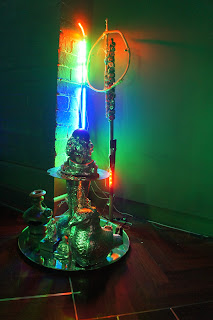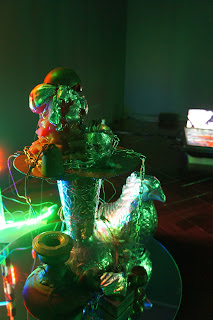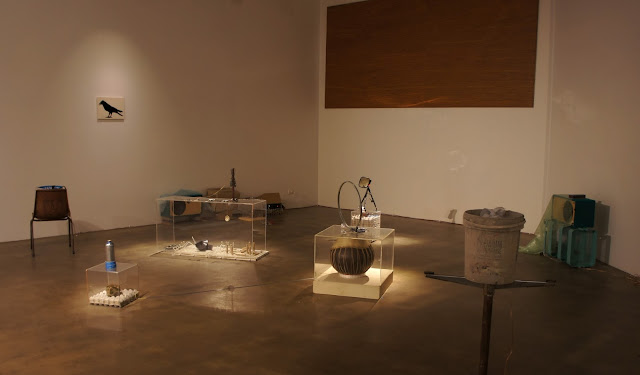dylanmartorell
Tuesday, August 9, 2022
Sunday, February 5, 2017
Seen and Not Seen - Music Video Production Studio
Seen and not seen is a production studio for audio-visual collaborations between Dylan Martorell and various members of Melbourne’s music and video art scene. Collaborators include Spinach Triangle, Hessian Jailor, James Grant, Benjamin Hancock and Lichen Kelp as well as members of Ambulance, Judo Bronze and Amphibious Vehicle.
Handmade instruments, improvised choreography, robotics and DIY electronics will be combined with green screen video, various sculptural props and primitive special effects to create a series of music videos onsite with this impromptu collective of practitioners. The remnants of the music videos will make up an accumulative installation. Album cover artwork will adorn the walls and a number of screens will feed back the finished artworks as they’re produced.

Live performance video stills Mathew Brown, Lichen Kelp, Lichen Kelp and Oliver Hextal
The open studio format will allow the public to witness the often unseen creative act of music and video production in its various phases of creation. Viewers are encouraged to drop in during gallery hours throughout the exhibition to view the work in progress from day one – Wed Oct 26 – before the results of Martorell’s various music video workshops and collaborations are unveiled during the public event two weeks into the project – Sat Nov 5 – for an open afternoon of video viewing and live performance.***Public event and performances
Saturday November 5, 2-5pmTable Publication and text by
Table is a new from publication (True Belief) edited by Dell Stewart. With contributions from Margaux Williamson, Sarah Weston, Amy Vuleta, Anna Varendorff, Manon Van Kouswijk, Meredith Turnbull, Nat Thomas, Dell Stewart, Tai Snaith, Dylan Martorell, Rachael Hooper, Kelly Fliedner, Nic Dowse, Adam Cruickshank. 201 96 pages / full colour / perfect bound / soft cover / dust jacke
ISBN 978-0-9871705-7-6
Dylan Martorell, Table top
Dylan Martorell’s tables, and the objects upon them, engage with a world and a language familiar to all of us, borrowing from the sphere of objects necessary to, or found within, the home. They are the objects we live with and use everyday: succulents in pots, rocks, sand and rope from the garden; bananas, potatoes, corn cobs and kernels, and other foods; bowls, cups, empty tins and cans, plastic trays, containers, vases and wine goblets, as well as other articles from the kitchen. These sit next to, below or on top of objects (perhaps more usually) used in the creation of art, music and performance: speakers, musical instruments (intact and dismantled), amplifiers, earthing wires, circuit boards, usb sticks, stationary, beads and clay. Woven amid all of these formations are pieces of discarded rubbish, waste material, plastic, detritus and refuse from both the home and the studio.
Self-sufficient and contained, these are fleeting assemblages and one off conglomerations formed for an exhibition or event, chained to that time and that space. For one moment Martorell’s collected objects, come together as microcosms atop make shift counters and card-tables. They are repurposed and ready to be played, to generate sounds and to create music. Site-specific, these works, such as the Kochi studio table top (2015), engage with their surroundings, by scavenging objects from, or evoking the histories of them (in this instance, narratives of past residents and of past uses as a site of international spice trade). After, the works are pulled apart, dismantled and released back into the world for another arrangement at a later date.
Martorell’s tables suggest both functionality and contemplation. The nature of his assemblage and the act of bringing together is transformative. A functional object, such as a glass used for drinking, becomes a vessel for the creation of reverberating sound, while in conjunction with other glass objects, becomes a sculpture that reflects light, gathering a formal aesthetic appeal. Here the table becomes the point of transformation, whereby objects that are intended to be played are also to be looked at; objects to be heard are also to be touched. There is a collapsing of distinction from object to performance, from sculpture to music, and further slippage back and between the two as the work is activated and deactivated by utility and performance.
Within the context of the exhibition space, Martorell’s works are often self generating, kinetic assemblages that create acoustics riffing off the natural ambiance of the room, activated by the audience, or are simply left idle—as idols—for the duration of opening hours until they are next animated by some event or performance. Martorell creates spaces that are sites of flux, where the potentiality of a work is unclear but present. If these inactive works were encountered within the space of a gallery, or as presented here within these pages, as mere sculptural documentation, the audience will likely still understand that by virtue of their work-bench nature, their intimate aesthetic and their inclusions of objects like speakers and conductors, that they have the potentiality for performance.
Through this potentiality Martorell’s tables become delineated stages and receptacles of latent energy. Like a dinner or kitchen table, through the ritual of its daily activation, the works take on an aura that is more than the sum of their parts. Just as the kitchen table is activated at regular daily intervals with conversation and action, these table tops become platforms for the process of ritual and storytelling. The kitchen table is the site where we habitually return to consume, converse and therefor narrativise our existence. And so too, do Martorell’s tables demand a certain amount of time in order to create sounds and synchronise with their surroundings, becoming a space for the audience to connect and project through either expected or recently consumed performances. They become a space where the audience encounters bordered events, creating moments of ‘off’ and ‘on’, connecting to the circadian narratives of home and life.
If the table is a border and a stage, it is also a frame. And as a title can effect the reading of a work, so too the table as a frame revises the collection upon it. Here the table becomes a necessary agent or focal-point within the collaboration, or conversation between artist, audience and object. Not so much in the definition of their use, but perhaps as a useful way of telling us what they are not: ‘these glasses stacked here on this table are not for ‘drinking’, they are for ‘playing’’; or, ‘this piece of tube and concrete is not merely a forgotten remnant, but part of this orchestra of objects’. By virtue of its boundaries, thetable facilitates the conversation, anchoring otherwise floating objects. Likewise, perhaps Martorell’s practice, which includes many ongoing and one-off collaborative arrangements, requires the table for conversation—to draw out or define the terms of those collaborations.
These modes of bordering, staging and framing are not to undermine the complexity and often messiness of Martorell’s tables, which perhaps reflect the frenetic environment of the home (or at least some homes) as a place that juggle the needs of multiple family members. Martorell’s works evoke these multipurpose spaces that slip between utility and work, leisure and relaxation, while evoking a history of art within the domestic sphere. They function as cultural criticism and depict how the creative and poetic image can gather all the complexity and chaos of a historical moment.However there is rhythm to their chaos, an internal logic to the formal and aesthetic decisions of each assemblage, as well as a particular politic expressed through the selection of such domestic, up-cycled and scavenged objects that finds confluence upon the table top. The table tops becomes a political commitment that is not indifferent to their aesthetic, but one that makes comment upon the disenfranchisation of art made within the home (predominantly by women), of climate change and the environment, and of the movement and circulation of people and materials around the world.
Through Martorell’s interest in the politics of collaboration and recycling, environmental sustainability and cultural exchange, there is a considered understanding of the complexity of labor. Present is the knowledge that in the creation of an art object, there is a history of practice and making that become the tools of that design, and for Martorell that is expressed not just in the language of selected found objects and the history of the readymade, but in the posture, performance and action of the artist in relation to the object, with an interest in narratives that level hierarchies that relegate the domestic as inferior, and, in the ethos of recycling commercial products and materials. Here, sedimented within the image created on the table top are the details of those various histories of politics and art.
more details here
From The Collection ; Gertrud Contemporary Regional Residencies
From the Collection: Gertrude Contemporary Regional Residencies, Chapter ThreeArtists: Sarah crowEST, DAMP, Nathan Gray, Dylan Martorell
Curated by Emily Cormack
Curated by Emily Cormack
Benalla Art Gallery
Botanical Gardens
Bridge Street, Benalla, Victoria
Botanical Gardens
Bridge Street, Benalla, Victoria
Exhibition Dates: 5 September – 25 October 2015
Opening Celebration: Saturday 5 September 2015, 2-5.30pm
Opening Celebration: Saturday 5 September 2015, 2-5.30pm
Gertrude Contemporary is pleased to present From the Collection: Chapter Three at Benalla Art Gallery, which is the third and final exhibition in the From the Collection series. This series of exhibitions has seen eighteen of Australia’s most innovative contemporary artists explore the permanent collections of three regional art galleries (previous venues are Warnambool Art Gallery and Latrobe Regional Gallery), using them as a starting point for twelve major new art commissions. For Chapter Three of the project, curator Emily Cormack has invited artists Sarah crowEST, Nathan Gray, Dylan Martorell, and artist collective DAMP to respond to Benalla Art Gallery’s collection.
Each of the selected artists has ventured into the vaults of the Benalla Art Gallery, spent time in the region, and in the process have uncovered a wealth of artworks and objects that they have then transformed and embedded into their own practices. DAMP has selected works from the BAG collection to be reconfigured as paintings on the surfaces of ceramic vessels. The seemingly simple transposition of a painting from canvas to ceramic is complicated by a gesture of violence: first, DAMP smashes the ceramic object, then they paint its broken pieces, and finally they reconstruct the ceramic object to produce a ‘subjective interpretation’ of the original artwork. crowEST has made a series of Ned Kelly-esque costumes (comprising masks, smocks and collars) inspired by works from the BAG collection, including The Lady in Pink by William Dobell, Beach Scene by Clarice Beckett, and Listening by Danila Vasilieff. Gray has produced a performative sound artwork by treating the object files in BAG’s collection database as a score that has the potential to be enacted. And Martorell has created interactive sound sculptures that sonify paintings from the BAG collection that he considers to be in some way already ‘noisy.’ Martorell’s selection includes paintings by Sally Smart, Turkey Tolson, Siri Hayes, and Robert Jacks.
In contrast with the previous two chapters of From the Collection, this exhibition specifically invites the viewer to physically engage with the artworks—focusing on ideas of play, improvisation and the handmade. For instance, DAMP will present a ceramic painting workshop where audiences will have the opportunity to make their own ceramic sculptures and potentially display these alongside the artists’ works (more details below). Visitors to the exhibition will also be invited to try on crowEST’s collection of hoods and tunics, which feature text and imagery lifted from works in the collection.
The artists in Chapter Three build instruments, write scripts, compose scores, make sounds, sew costumes, and paint ceramics—all offering multiple opportunities for visitors to Benalla Art Gallery to explore their own expressions of creativity, and to rethink their local art collection.
Public programs on Saturday 5 September 2015:
12-2pm — Ceramic painting workshop with artists collective DAMP (Bookings essential on 03 5760 2619. For ages 15+)
2pm — Exhibition tour with Gertrude Contemporary curator Emily Cormack
2-5.30pm — collaborative durational performance by Sarah crowEST and Nathan Gray
4 - 5.30pm — Exhibition opening. Guest speaker Emily Cormack, Curator, Gertrude Contemporary
2pm — Exhibition tour with Gertrude Contemporary curator Emily Cormack
2-5.30pm — collaborative durational performance by Sarah crowEST and Nathan Gray
4 - 5.30pm — Exhibition opening. Guest speaker Emily Cormack, Curator, Gertrude Contemporary
Public programs on Sunday 6 September 2015:
12-2pm — Ceramic painting workshop with artists collective DAMP (Bookings essential on 03 5760 2619. For ages 15+)
From the Collection is supported by the Victorian Government through Creative Victoria. This project has also been assisted by the Australian Government through the Australia Council, its arts funding and advisory body. This project also received development funding from the National Exhibitions Touring Service (NETS) Victoria.
Company of Strangers
- See more at: http://artguide.com.au/whats-on-page/show/percy-grainger-in-the-company-of-strangers/#sthash.CZMzIfKr.dpuf
This exhibition presents and explores the aspect of the polymath in Percy Grainger's personality and in those
of contemporary Australian practitioners. John Brooks, Dylan Martorell, Alasdair McLuckie, Rebecca Monaghan,
Darren Sylvester and Kate Tucker have each responded to objects held in the Grainger Museum,
producing tactile works that push the boundaries of popular aesthetics and social norms.
The Gallery at Bayside Arts and Cultural Centre
Corner Carpenter and Wilson Streets,
Brighton, VIC, 3186
03 9592 0291
www.bayside.vic.gov.au/Bayside_Arts_and_Cultural_Centre.htm
Weds to Fri 11am - 5pm, Sat and Sun 1pm - 5pmBrighton, VIC, 3186
03 9592 0291
www.bayside.vic.gov.au/Bayside_Arts_and_Cultural_Centre.htm
Slow Art Collective - Castlemaine State Festival
Slow Art Collective (Chaco Kato, Dylan Martorell) Edgar Hechavarria Ricardo,
students from Castlemaine Secondary College
Loomūsica is the Castlemaine State Festival’s signature arts mentorship
project bringing together Slow Art Collective, Cuban artist Edgar
Hechavarria Ricardo, and students from Castlemaine Secondary College.
Together they will create a site-specific installation that honors the
manufacturing history of the former Castlemaine Woollen Mills.
Utilising re-purposed materials found on site and incorporating
kinetic sculpture, robot components and basic DIY electronics,
Loomūsica plays with the notions of loom and harp.
more information : http://castlemainefestival.com.au/2015/event/loomusica
Loomūsica is the Castlemaine State Festival’s signature arts mentorship
project bringing together Slow Art Collective, Cuban artist Edgar
Hechavarria Ricardo, and students from Castlemaine Secondary College.
Together they will create a site-specific installation that honors the
manufacturing history of the former Castlemaine Woollen Mills.
Utilising re-purposed materials found on site and incorporating
kinetic sculpture, robot components and basic DIY electronics,
Loomūsica plays with the notions of loom and harp.
more information : http://castlemainefestival.com.au/2015/event/loomusica/
students from Castlemaine Secondary College
Loomūsica is the Castlemaine State Festival’s signature arts mentorship
project bringing together Slow Art Collective, Cuban artist Edgar
Hechavarria Ricardo, and students from Castlemaine Secondary College.
Together they will create a site-specific installation that honors the
manufacturing history of the former Castlemaine Woollen Mills.
Utilising re-purposed materials found on site and incorporating
kinetic sculpture, robot components and basic DIY electronics,
Loomūsica plays with the notions of loom and harp.
more information : http://castlemainefestival.com.au/2015/event/loomusica
Loomūsica is the Castlemaine State Festival’s signature arts mentorship
project bringing together Slow Art Collective, Cuban artist Edgar
Hechavarria Ricardo, and students from Castlemaine Secondary College.
Together they will create a site-specific installation that honors the
manufacturing history of the former Castlemaine Woollen Mills.
Utilising re-purposed materials found on site and incorporating
kinetic sculpture, robot components and basic DIY electronics,
Loomūsica plays with the notions of loom and harp.
more information : http://castlemainefestival.com.au/2015/event/loomusica/
Illuminator / Utopian Slumps Gallery
Solar Action #1 and #2 from dylan martorell on Vimeo.
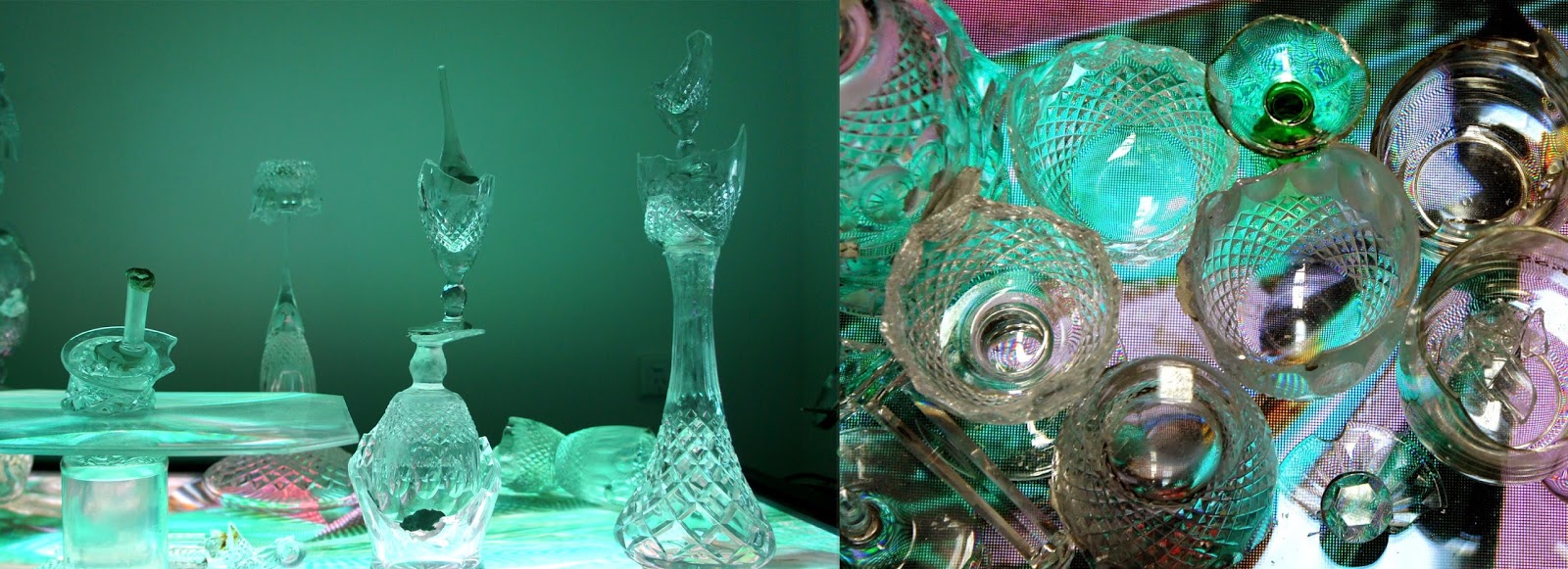
Music from Fraxinus Ash graphic scores. Performed by James Rushford, Joe Talia and Dylan Martorell. Recorded by Sam Karmu and Joe Talia
Address: 33 Guildford Ln, Melbourne VIC 3000
Hours: Wed—Sat 12—5pm during exhibition period
other times by appointment
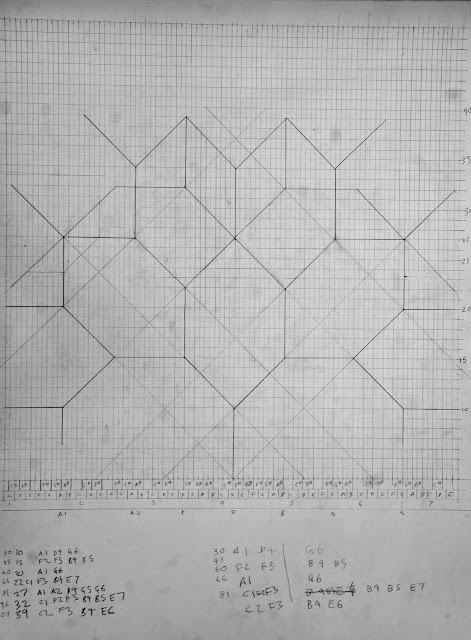
FUTURE PRIMITIVE
23 NOVEMBER 2013 - 02 MARCH 2014
23 NOVEMBER 2013 - 02 MARCH 2014
Future Primitive conveys a link to modern twentieth-century art inspired by indigenous artefacts—a history that is the subject of works by artists such as Narelle Jubelin, Daniel Boyd, and Alasdair McLuckie, who are among eighteen artists from Australia and New Zealand included in the exhibition. More broadly, the exhibition draws together a range of work by artists who conjoin modernist ideas or forms with atavistic, totemic or tribal motifs, employ traditional handcrafts or fundamental materials and ways of making such as ceramics or weaving to contemporary ends, or forge their personal style/ identity through images or ideas they identify with across cultures and times. Some of the artists turn the table on modernist primitivism and explore its specific local histories, some make reparative gestures, attracted to what joins cultures or communities rather than what divides, others provoke questions and sidestep the usual decorum around the subject. Many of the works move forward and back between past and future, presenting the ‘primitive’ as a going back to origins, whether ancestral, animal, or cultural, in an attempt to find out how to live better in a world in crisis or to question its values.
Other artists in the exhibition include Sarah Contos, Mikala Dwyer, Graham Fletcher, David Griggs, Fiona Hall, Newell Harry, Siri Hayes, Brendan Huntley, Jess Johnson, Dylan Martorell, , Sanne Mestrom, TV Moore, Michelle Nikou, Ricky Swallow and Rohan Wealleans.
Venue Heide III: Central Galleries
Curator Linda Michael
Exhibition Tours
Tuesday 26 November, 2pm
Volunteer Guide
Cost FREE (with admission)
Tuesday 26 November, 2pm
Volunteer Guide
Cost FREE (with admission)
Saturday, February 4, 2017
Asian Art Biennale - Everyday Life .National Taiwan Museum of Fine Arts - Taichung, Oct 2013
Capacative touch sound installation utilizing local sound sources,(material based sounds, field recordings, instrument recordings) and materials sourced from abandoned housing estates /flea markets.
Participants activate the multi-user instrument through touch. Various Taichung based sound elements are triggered through contact with various conductive materials ,(aluminium covered icons,massage tools,cans, musical objects etc) The floor of the exhibition space is earthed through a network of copper tape.Participants earth themselves through the removal of any footware which might break the circuit of conductivity.e.g.rubber soles.
Various conductive materials sourced from abandoned housing estates.
Copper earthing for gallery floor.
First percussive robotics performance abandoned housing estate central Taichung.
Second percussive robotics performance TMFA
Robotic percussion instruments where created with the assistance of
Keith Urquhart - programming
Mat Valdman - Engineering
Sourcing materials at abandoned housing estate entral Taichung
Subscribe to:
Posts (Atom)











